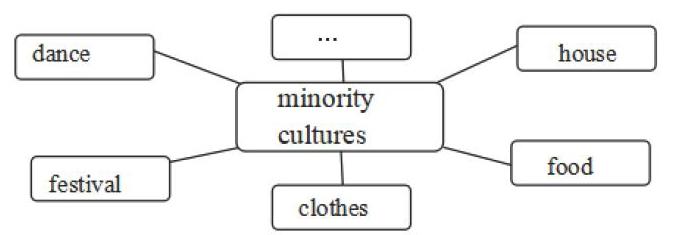A Teaching Plan for Unit 5 Theme Parks
2020-04-10飞雪梅
飞雪梅

Students level: Senior 2 Teaching Duration: 40minutes
Teaching content: PEP Edition Book 3 Unit 5 Theme Parks—listening and speaking
I. Teaching aims:
1. Knowledge aims
(1) To enable the students to introduce a theme park by using the function phrases and sentences: They celebrate…by doing…; …is one of the most popular….
(2) To help the students review and grasp the words in Unit 5: theme park, minority, celebrate, experience.
(3) To help the students learn about Chinese minority cultures.
2. Ability aims
(1) To develop the listening skills to grasp specific information.
(2) To develop the speaking skills to introduce minority cultures briefly.
(3) To develop the speaking skills to express interests in the minority cultures.
3. Emotional aims
(1) To cultivate patriotism by learning more about the minority cultures.
(2) To enhance confidence in Chinese culture and raise the students awareness of spreading Chinese minority cultures.
(3) Strengthen the sense of cooperation with others.
II. Important and difficult points of teaching:
Guide the students to make a role play by using the words, phrases and sentence structures learned in the class.
III. Teaching methods:
1. Task-based Language Teaching.
2. Communication-based Language Teaching.
IV. Teaching procedures:
Step 1. Lead-in (1 minute)
Enjoy a song before class to arouse the students interest in this class and then introduce the topic of minority cultures, Yi People and the first Yi Autonomous County---Eshan with a song.
【設计意图】:通过课前欣赏学生比较熟悉的《七月火把节》这首歌曲,营造轻松愉快的氛围。同时结合峨山县学生的实际情况,引出彝族的话题,激发学生的学习兴趣,也为本堂课所要拓展的主题公园类型——少数民族文化主题公园埋下伏笔。
Step 2. Warming up (5 minutes)
1. Show some pictures about the culture of Yi People and guide the students to introduce the festival, food, clothes and house of Yi People in sentences:
(1) They are celebrating the Torch Festival by singing and dancing.
(2) Pounded Chicken is one of the most popular foods in Yunnan.
(3) They are dancing in their folk clothes, which are beautiful and colorful.
(4) The houses Yi People live in are called adobe houses.
And then guide the students to have a brainstorm by making a mind map:
【设计意图】:通过欣赏有关彝族文化的图片,引入celebrate, the Torch Festival, Pounded Chicken等词汇和They celebrate…by doing…; …is one of the most popular两个重点句型,为听力练习和对话做准备。同时,引导学生通过mind map的形式,梳理少数民族文化涵盖的内容:festival, food, clothes, house, dance等,从思维和文化层面为听力和对话练习做铺垫。
2. Lead into the theme park—Yunnan Folk Culture Villages.
【设计意图】:引出听力对话中将要出现的三个人物:两个美国游客和一个导游,以及本堂课的主題公园——云南民族村,让学生对听力材料做听前预测。
Step 3. Listening (15 minutes)
Task 1. Listen to the conversation and pick out(√) the subjects that they are talking about.
( ) clothes ( ) food ( ) houses
( ) language ( ) festivals ( ) history
【设计意图】:听力材料是根据本堂课的教学目标而设计的。通过泛听,让学生了解对话中有关彝族文化的话题。
Task 2. Listen again and choose the best answer to each question.
1. What do Yunnan Folk Culture Villages show?
A. They show very interesting activities in different places in Yunnan.
B. They show different cultures of different minorities in Yunnan.
C. They show different attractions(景点) in Yunnan.
2. How do the Yi People celebrate their festival?
A. By splashing(泼) water on each other.
B. By holding a dragon-boat race.
C. By dancing and singing around a big burning fire.
【设计意图】:通过泛听及选项的学习,让学生了解云南民族村这一主题公园的主题——少数民族文化,以及彝族火把节的庆祝方式。同时加深学生对重点单词celebrate的印象。
Task 3. Listen again and complete the conversations.
Guide: Hello, everyone! Im Mark, your guide. Yunnan Folk Culture Villages. This is a theme park which shows the different of different minorities in Yunnan, such as Dai, Hui, Yi, and Miao. Ok, now, lets go to the first station---the Yi Village. Yi People are very kind and hardworking. They are their special way of .
Visitor A: Would you please tell us more about it?
Guide: Yes, of course. As you walk around the Yi Village, you can see how they live, and what they and . You can even their life.
Visitor B: Do they have their own special clothes, some clothes that are quite
different from other minorities?
Guide: Sure. Look, this is the clothes of the Yi people. They are very beautiful and , arent they?
Visitor B: Wow!What about their food? Do they have some unique food?
Guide: Hmm…Yep…the Pounded Chicken is the most . It tastes delicious, but a little bit spicy.
Visitor A: I see. What festival do they ?
Guide: That would be the Torch Festival. The Yi People usually celebrate it
and singing around a big burning fire.
Visitor B: Wow, thats really interesting! No wonder its charming.
【设计意图】:通过细听,训练学生对特定信息的捕捉能力,同时植入一些用于介绍少数民族文化的词汇、短语和句型,并对其阴影标注,通过视觉效应及课堂齐读的方式进行强化,为下一环节的Speaking做好准备。
Step 4. Speaking (Role-play) (18 minutes)
Role playⅠ. Learn from the sample and make a role play.
Sample:
Guide: Hi, Nice to meet you! Im your guide, Mark. Welcome to the Yi Village.
Visitor A: Nice to meet you, too. Would you please tell us something special about Yi People?
Guide: Yes, of course. They are famous for the festival—the Torch Festival. They celebrate it by singing and dancing.
Visitor B: Wow, how charming! What about their food? I want to taste it.
Guide: Hum… good idea. One of the most popular food is the Pounded Chicken. It is delicious. Lets go and have a taste.
Visitor A: We really enjoy ourselves today!
【設计意图】:以参观彝族村为例,拓展学生的发散性思维,通过填空、完成对话、分角色朗读的形式,巩固单词、短语和句型的使用,使学生明确如何扮演游客和导游的角色,为下一个新情景的角色扮演做好铺垫。
Role playⅡ. The guide is showing two visitors around the Hui Village or the Dai Village. Work in groups and make a role play by using:
(1) Important sentence structures in Listening part.
(2) Key words and phrases on the black board:minority, celebrate by doing, experience sth.
(3) The materials (pictures and expressions) on learning paper.
peacock dance孔雀舞, finger-feeding food手抓饭, Water-splashing Festival泼水节, bamboo house竹楼
scarf头巾, mosque清真寺, beef牛肉, the Month of Fast斋月
Possible dialogue 1
Guide: Hello, Nice to meet you! Im your guide, Mark. Welcome to___________.
Visitor A: Nice to meet you, too. Would you please tell us _________?
Guide: Yes, of course. They are famous for ____________.
Visitor B: Wow, how ! What about ? I want to .
Guide: Hum… good idea. It is . Lets go and .
…
Possible dialogue 2
Guide: (greetings)
Visitors: (greetings)
…
【设计意图】:通过新情景的角色扮演,强化学生对重点词汇、短语和句型的使用,让学生学会介绍少数民族文化,传播中国文化,调动学生学习英语的积极性和参与性,培养和增强学生的民族自豪感。为关注各个层次的学生,提供了两种可能的对话模板:possible dialogue 1针对英语基础薄弱的学生,通过填空的形式以降低任务的难度,possible dialogue 2 针对英语基础好的学生而设置,以发挥他们的创造性来进行角色扮演。
Step 5. Homework(1 minute)
假如你是李华,你的英国笔友汤姆想要了解你的家乡—峨山。请用这节课上所学到的短语和句子及相关内容写一封E-mail,介绍你家乡的少数民族文化。
【设计意图】:结合高考写作要求和本堂课的学习要点,让学生通过写作来巩固学习的重点内容,更增强了语言学习的实用性。
